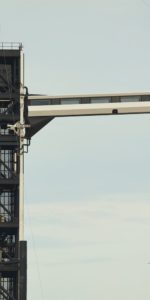
United Launch Alliance (ULA) is now targeting Dec 10 to launch the long-delayed NRO-44 mission for the U.S. National Reconnaissance Office (NRO) from Cape Canaveral Air Force Station, Fla, following repeated scrubbed launch attempts atop a Delta IV Heavy rocket dating back to August. Liftoff of the 235-foot-tall (72-meter) beast—which comprises three Common Booster Cores mated together—is set for 5:50-10:30 p.m. EST, pending range availability.
The rocket has been at its seaside launch complex 37B now for over a year, initially expected to fly in June 2020. The rationale for the longer-than-normal pad processing flow remains unclear, although fitting this mission’s pre-flight milestones in between other flights earlier in the year clearly played a role. ULA conducted a fully-fueled Wet Dress Rehearsal (WDR) in the second week of January, before being postponed (for still unknown reasons) from June to Aug 26. The NRO then requested an additional day of delay to the 27th.

Then the technical gremlins moved in for the summer…and part of the fall, too, as circumstances would transpire. Launch on Aug 27 was scrubbed due to a ground pneumatics control system issue and clocks were recycled for a second try in the wee hours of Aug 29. On that occasion, the countdown reached T-3 seconds, before the Terminal Countdown Sequencer Rack (TCSR) autonomously (and dramatically) commanded a “Hot Fire Abort”.
As is characteristic of the Delta IV Heavy’s staggered engine-start and ramp-up sequence, the starboard-side CBC roared to life as planned at T-7 seconds, but the proper conditions were not met for the ignition of its center and port-side counterparts at T-5 seconds. Another launch was ignominiously called off as ULA initiated an investigation, which zeroed-in on one of three pad-side regulators. All three were removed, refurbished and tested, before being reinstalled into the Delta IV Heavy.

But misfortune was far from done with the beleaguered mission. Hopes of flying on 26 September came to nought when a hydraulic issue with SLC-37B’s swing-arm system arose, forcing an additional three-day slip. Two more back-to-back scrubs were then enforced by the intractable Florida weather, with lightning warnings and a need to remove the pad crew to safety eating into their respective countdown operations. A hydraulic hose failure in the Mobile Service Tower (MST) piled yet more frustration onto the proceedings.
Finally, another attempt geared up for liftoff just before midnight on 30 September. Countdown operations proceeded smoothly, with the weather outlook classified as “Green” and the only issue of any concern was an issue pertaining to the review of data readings. Anomaly Chief Dave McFarland and his team determined that a computer-controlled redline limit would be monitored manually, to avert the potential risk of a data readings issue from tripping up the terminal countdown. A slow-to-respond pad swing-arm sensor was “masked-out” to prevent it posing any further problems.

All went smoothly, again, until the final moments before the targeted launch. At T-14 seconds, the pad-side Radial Outward Firing Igniters (ROFIs) came to life like glittering sparklers to clear unburnt hydrogen from the vicinity of the engines. But as the last seconds ticked away, something did not look quite right, for the engine-side ROFIs did not fire. At T-7 seconds, with the same ominous pall of ashen-gray smoke last seen on 29 August, the Delta IV Heavy seemingly came alive, then fell silent, as abort calls rang out across the net.
“We experienced an automated abort because a sensor reported a fault,” tweeted ULA CEO Tory Bruno in the aftermath of the scrub. “Automated Safety System operated as intended. Bird and payload are safe and unharmed. Engine ROFIs were not fired. Turbopumps were not spun up. Mission safety first.”

As frustrating as yet another scrub for the snakebitten Delta IV Heavy might be, the rocket’s safety systems performed as advertised. “Recycle is always a better trade,” tweeted Mr. Bruno, “than the risk of killing a billion-dollar payload that took many years to build.” Initial hopes of flying as soon as Oct 15 came to nothing and ULA ultimately announced a new target of Oct 23, “to allow our team to perform additional analysis and data-monitoring of ground systems to ensure they continue to perform nominally”.
That date also came ultimately to nought tho, when ULA then announced that NROL-44 was delayed indefinitely, noting “with continued emphasis on mission success, our team will continue to test and evaluate the swing-arm retraction system prior to the launch. We will confirm a launch date as soon as possible.”
Follow our NROL-44 LAUNCH TRACKER for updates and live coverage of the launch!
.
.
FOLLOW AmericaSpace on Facebook and Twitter!
.
.





